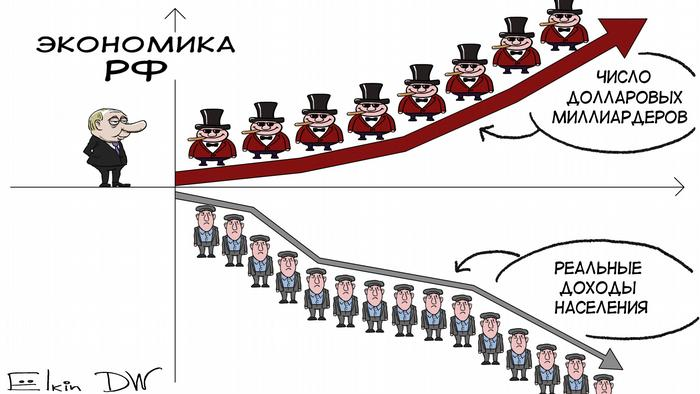What do we see?
In this cartoon, we see a simple Cartesian graph. A satisfied and slightly overweight Putin, depicted with a big nose, is standing on the horizontal axis of the graph. The upper quadrant of the graph contains a thick red arrow sloping upwards labelled “the number of dollar billionaires”. Eight overweight prototypical dollar billionaires are standing along the line, elegantly dressed in red jackets, top hats, sunglasses and smoking cigars. The grey arrow in the lower quadrant of the graph slopes downwards and represents “the real income of the population”. Fifteen typical citizens of the Russian Federation are standing side by side along the grey line dressed in grey suits, blue shirts and simple grey caps. The cartoon shows that while the number of billionaires is growing in Russia, the real income of the population is falling.
What public issue is addressed here?
According to Forbes, in 2018, 29 new dollar billionaires appeared on the Russian economic scene. This provoked a series of articles, some cartoons and conferences that criticized and commented on the state of Russian economy. Billionaires own 35% of Russia’s GDP highlighting a situation that would be critical in a more developed country. The belongings of one single dollar billionaire, Aleksej Mordashev, make up 1.7 % of the entire Russian economy. There is a narrative in Russia about “good” and “bad” billionaires: good billionaires are those that made their fortune in technology and services, bad billionaires made their money in energy and as property owners. The latter are considered ‘bad’ because these two sectors are more prone to corruption and often follow market rules for quick profit. In Russia, 60% of all billionaires are considered to belong to the so-called bad category. The state of the economic elite in Russia is on a par with Botswana’s and lower than that of Indonesia and Kazakhstan.
What does the humour do?
This cartoon mocks complex economic graphs and calculations produced by the Russian state with a simple Cartesian graph consisting of one line, made up of billionaires, that is steeply sloping upwards, and another, representing the real income of the population sloping sharply downwards. Putin is ridiculed — while he is dressed in business attire, he is standing in line with the billionaires and, in addition, his long nose suggests that he is lying. Billionaires are depicted as caricatures, and while there are honest businessmen in Russia, the cartoonist portrays the group as classic fat capitalists in hats and with big cigars, of which there is a rich history in the country’s communist past. The depiction of the common citizen does not include humour, as they are portrayed as simply sad and seemingly accepting their fate.
